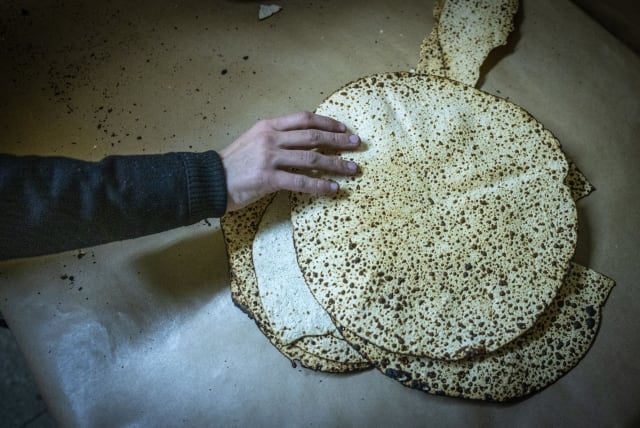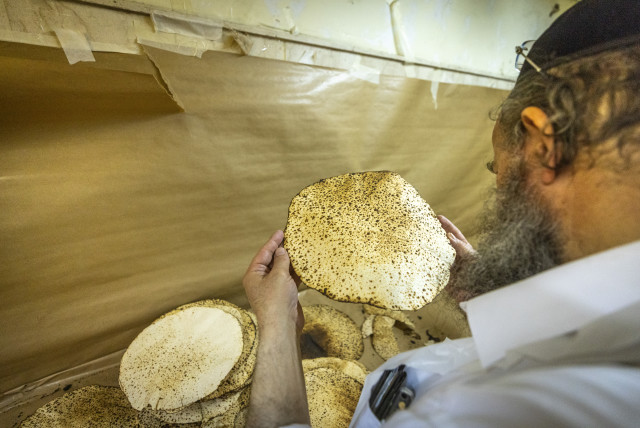To mark our brokenness this Passover, let’s scale back the matzah on our seder tables - opinion

We often assume matzah represents suffering, but the original design of the seder didn’t focus on matzah’s taste or shape, but rather symbolic power of wholeness - or brokenness.
How might we celebrate Passover differently this year? With so many Israelis brutally murdered on Oct. 7, so many soldiers killed or wounded in battle, so many people — Palestinians and aid workers — dead or suffering in Gaza, we cannot simply celebrate as we did last year. As a community, we need to encourage ritual innovations or special readings to address all these tragic realities.
I want to focus on one aspect of a post-Oct. 7 seder: a ritual change meant to call our attention to the more than 130 hostages — men, women and children — still captive in Gaza after more than six months. I make this proposal with some trepidation; after all, one of the parts I love about our family’s seder is the predictability of the rituals, even down to the same melodies for the songs, year after year. And as a rabbi who studies liturgy, I appreciate the constancy of the words and symbols of the seder.
And yet, making no change this year in the rhythm of the seder seems tone deaf to me. I wondered: Is there a change we could make that itself is traditional, and yet reflects our current moment?
A new, albeit powerful, shift this year
With this in mind, I propose a very simple but powerful shift in the food at the seder: Instead of the three matzot that are included on the seder table (usually wrapped or covered in cloth), use only two. When it comes time to break one of the matzot to hide half for later (the afikomen), we will have only one and a half matzot left.
At the meal which begins with eating matzah, instead of abundance we will feel absence.
Using one and a half matzot at the seder meal, instead of two and a half, is actually an ancient tradition, reported in the Talmud (Berakhot 39b). Indeed, it is meant to symbolize the scarcity that we experienced when we were in captivity in ancient Egypt (note: their matzah was softer than ours):
Rav Papa said: All agree that on Passover one places the broken piece inside the full one and [says the blessing]. What is the reason? Because it is written (about matzah in Deuteronomy 16:3) lehem oni — “bread of suffering/poverty.”
Throughout Jewish history, leading authorities such as Rabbi Yitzhak Alfasi and Maimonides (Laws of Hametz and Matzah 8:6) reported using only one and a half pieces of matzah at the meal. Rabbi Isaac of Vienna says explicitly (Or Zarua 2:252) that according to the Talmud, one needs only two matzot, not three.
Matzah is a complex symbol. Elsewhere in the haggadah, Rabban Gamliel says it represents our redemption. But Rav Papa insists that matzah is also — and perhaps chiefly — a symbol of our suffering. We begin the telling portion of the seder by lifting the matzah and calling it “bread of suffering/poverty” – Ha Lahma Anya (lehem oni in Aramaic).
We often assume matzah represents suffering because of its texture (challah is so rich in comparison). But the original design of the seder didn’t focus on matzah’s taste or shape for its symbolic power; after all, matzah was used year-round in the Temple for certain sacrifices. Rather it focused on its state of wholeness — or brokenness.
There was meant to be a shock element to the half piece of matzah. Normally, people celebrate Shabbat and holidays with two full loaves of bread — remembering the plenty that God bestowed in the desert through the manna (a double portion fell on Friday). Indeed, on the same page of the Talmud quoted above, we learn of this practice. But on Passover, Rav Papa reports, everyone agrees that there cannot be two full loaves. Rather, we come to our meal only with one and a half matzot. This — the brokenness and the diminished amount of food — is the bread of affliction, the symbol of suffering.
So why do we use two and a half matzot today? Many medieval authorities wanted to emphasize that Passover was no different from other festivals, which — like Shabbat — required two full loaves, so they added another matzah to the original one and a half. Now one could break a matzah in half, but still make the blessing with two remaining full pieces. Across Jewish communities, three matzot (with one broken) became the norm. Even Yemenite communities, which followed Maimonides with one and a half matzot for hundreds of years, eventually adopted the current custom of two and a half.
Of course, this solution softened the surprise meant to accompany the matzah; now we had more bread than regular festivals, not less. Strikingly, the Vilna Gaon, a leading authority of the 19th century, recommended bringing back the practice of one and a half matzot at the meal. If you have two and a half matzot, he said, then “this is not the manner of suffering!” (Beur Ha-Gra OH 473:4)
I am not recommending a permanent change to the seder. But this is not a normal year. With more than 130 of our people literally in captivity, the shock of seeing fewer matzot at the table, when we are used to seeing plenty, is appropriate. In fact, it is a version of the shock the seder was originally meant to induce: Unlike every other Shabbat and holiday, our bread, like our hearts, will be in pieces. This is the nature of matzah at the seder, as Rav Papa indicated: a reminder of our people’s long suffering in slavery before being redeemed.
My prayer is that next year we can celebrate with a full set of three matzot again. But for this year, let’s mark the suffering of those still in captivity by reducing our plenty and reclaiming the power of the “bread of suffering” at our seder.
The views and opinions expressed in this article are those of the author and do not necessarily reflect the views of JTA or its parent company, 70 Faces Media.
Jerusalem Post Store
`; document.getElementById("linkPremium").innerHTML = cont; var divWithLink = document.getElementById("premium-link"); if (divWithLink !== null && divWithLink !== 'undefined') { divWithLink.style.border = "solid 1px #cb0f3e"; divWithLink.style.textAlign = "center"; divWithLink.style.marginBottom = "15px"; divWithLink.style.marginTop = "15px"; divWithLink.style.width = "100%"; divWithLink.style.backgroundColor = "#122952"; divWithLink.style.color = "#ffffff"; divWithLink.style.lineHeight = "1.5"; } } (function (v, i) { });

